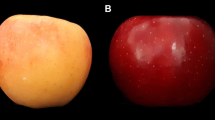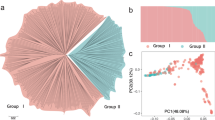Abstract
Fruit shape is a critical appearance quality in apple. Quantitative trait loci (QTLs) for apple fruit shape index (FSI) traits were previously mapped by our laboratory to linkage group 11 of the maternal parent in a cross population of ‘Jonathan’ × ‘Golden Delicious’ using simple sequence repeat markers. In this study, QTLs for fruit length, diameter, and FSI were identified again using a high-density single nucleotide polymorphism (SNP) genetic linkage map, and candidate genes associated with FSI were screened via whole-genome re-sequencing data for ‘Jonathan’ and ‘Golden Delicious’. Fifteen QTLs, including four for fruit length, one for fruit diameter, and ten for FSI, were identified in three sampling years. Two overlapping year-stable QTL regions related to FSI were anchored on LG 11 of ‘Jonathan’. One candidate gene (MDP0000135244) related to FSI in apple and encoding an LysM domain receptor-like kinase protein was predicted and verified in the segregated population. The nonsynonymous SNP (C11.6053728) of MDP0000135244 was present in 23 of 30 individuals with high FSI, demonstrating a close relationship between MDP0000135244 and FSI trait. These results will be useful for the application of marker-assisted selection for FSI trait in apple.



Similar content being viewed by others
References
Bateman A, Bycroft M (2000) The structure of a LysM domain from E. coli membrane-bound lytic murein transglycosylase D (MltD). J Mol Biol 299:1113–1119
Cao YR, Liang Y, Tanaka K, Nguyen CT, Jedrzejczak RP, Joachimiak A, Stacey G (2014) The kinase LYK5 is a major chitin receptor in Arabidopsis and forms a chitin-induced complex with related kinase CERK1. Elife 3:e03766
Celton JM, Tustin DS, Chagné D, Gardiner SE (2009) Construction of a dense genetic linkage map for apple rootstocks using SSRs developed from Malus ESTs and Pyrus genomic sequences. Tree Genet Genomes 5:93–107
Chang YS, Sun R, Sun HH, Zhao YB, Han YP, Chen DM, Wang Y, Zhang XZ, Han ZH (2014) Mapping of quantitative trait loci corroborates independent genetic control of apple size and shape. Sci Hortic 174:126–132
Cong B, Liu J, Tanksley SD (2002) Natural alleles at a tomato fruit size quantitative trait locus differ by heterochronic regulatory mutations. Proc Natl Acad Sci USA 99:13606–13611
Costa F, Stella S, Van de Weg WE, Guerra W, Cecchinel M, Dallavia J, Koller B, Sansavini S (2005) Role of the genesMd-ACO1 and Md-ACS1 in ethylene production and shelf life of apple (Malus domestica Borkh). Euphytica 141:181–190
Diaz A, Zarouri B, Fergany M, Eduardo I, Alvarez JM, Pico B, Monforte AJ (2014) Mapping and introgression of QTL involved in fruit shape transgressive segregation into ‘Piel de Sapo’ melon (Cucucumismelo L.). PLoS One 9:e104188
Dunemann F, Ulrich D, Boudichevskaia A, Grafe C, Weber WE (2009) QTL mapping of aroma compounds analysed by headspace solid-phase microextraction gas chromatography in the apple progeny ‘Discovery’ × ‘Prima’. Mol Breed 23:501–521
Durel CE, Denancé C, Brisset MN (2009) Two distinct major QTL for resistance to fire blight co-localize on linkage group 12 in apple genotypes ‘Evereste’ and Malus floribunda clone 821. Genome 52:139–147
Erbs G, Silipo A, Aslam S, De Castro C, Liparoti V, Flagiello A, Pucci P, Lanzetta R, Parrilli M, Molinaro A, Newman MA, Cooper RM (2008) Peptidoglycan and muropeptides from pathogens Agrobacterium and Xanthomonas elicit plant innate immunity: structure and activity. Chem Biol 15:438–448
Gardiner SE, Bus VGM, Rusholme RL, Chagné D, Rikkerink EHA (2007) Genome mapping and molecular breeding. In: Kole C (ed) Fruit and Nuts, vol 4. Springer, Berlin, Heidelberg, pp 2–62
Gustavo RR, Stephane M, Claire A, Sung-Chur S, Andrew M, Mathilde C, Brian BMG, David F, van der Knaap E (2011) Distribution of SUN, OVATE, LC, and FAS in the tomato germplasm and the relationship to fruit shape diversity. Plant Physiol 156:275–285
Hazbavi I (2014) Shape and size grading of apple fruit (cv. Fuji) based on geometrical properties. IJB 4:269–273
Huang N, Angeles ER, Doming J (1997) Pyramiding of bacterial blight resistance genes in rice: marker-assisted selection using RFLP and PCR. Theor Appl Genet 95:313–320
Huang XH, Paulo M, Boer M, Effgen S, Keizer P, Koornneef M, van Eeuwijk FA (2011) Analysis of natural allelic variation in Arabidopsis using a multiparent recombinant inbred line population. Proc Natl Acad Sci USA 108:4488–4493
Janssen BJ, Thodey K, Schaffer RJ, Alba R, Balakrishnan L, Bishop R, Bowen JH, Crowhurst RN, Gleave AP, Ledger S, McArney S, Pichler FB, Snowden KC, Ward S (2008) Global gene expression analysis of apple fruit development from the floral bud to ripe fruit. BMC Plant Biol 8:16
Kenis K, Keulemans J, Davey MW (2008) Identification and stability of QTLs for fruit quality traits in apple. Tree Genet Genomes 4:647–661
King GJ, Maliepaard C, Lynn JR, Alston FH, Durel CE, Evans KM, Griffon B, Laurens F, Manganaris AG, Schrevens T, TartariniS Verhaegh J (2000) Quantitative genetic analysis and comparison of physical and sensory descriptors relating to fruit flesh firmness in apple (Malus pumila Mill.). Theor Appl Genet 100:1074–1084
Krizek B (2009) AINTEGUMENTA and AINTEGUMENTA-LIKE6 act redundantly to regulate Arabidopsis floral growth and patterning. Plant Physiol 150:1916–1929
Kunihisa M, Moriya S, Abe K, Okada K, Haji T, Hayashi T, Kim H, Nishitani C, Terakami S, Yamamoto T (2014) Identification of QTLs for fruit quality traits in Japanese apples: QTLs for early ripening are tightly related to preharvest fruit drop. Breed Sci 64:240–251
Liu J, Van Eck J, Cong B, Tanksley SD (2002) A new class of regulatory genes underlying the cause of pear-shaped tomato fruit. Proc Natl Acad Sci USA 99:13302–13306
Madhumita D, Anish M (2012) The AINTEGUMENTA genes, MdANT1 and MdANT2, are associated with the regulation of cell production during fruit growth in apple (Malus × domestica Borkh.). BMC Plant Biol 12:98
Mizukami Y, Fischer RL (2000) Plant organ size control: AINTEGUMENTA regulates growth and cell numbers during organogenesis. Proc Natl Acad Sci USA 97:942–947
Moriya S, Okada K, Haji T, Yamamoto T, Abe K (2012) Fine mapping of Co, a gene controlling columnar growth habit located on apple (Malus × domestica) linkage group 10. Plant Breed 131:641–647
Padmarasu S, Sargent DJ, Jaensch M, Kellerhals M, Tartarini S, Velasco R, Troggio M, Patocchi A (2014) Fine-mapping of the apple scab resistance locus Rvi12 (Vb) derived from ‘Hansen’s baccata #2’. Mol Breed 34:2119–2129
Rate DN, Greenberg JT (2001) The Arabidopsis aberrant growth and death2 mutant shows resistance to Pseudomonas syringae and reveals a role for NPR1 in suppressing hypersensitive cell death. Plant J 27:203–211
Rosyara UR, Bink MCAM, van de Weg E, Zhang GR, Wang DC, Sebolt A, Dirlewanger E, Quero-Garcia J, Schuster M, Iezzoni AF (2013) Fruit size QTL identification and the prediction of parental QTL genotypes and breeding values in multiple pedigreed populations of sweet cherry. Mol Breed 32:875–887
Sarah MP, Khan MA, Han YP, Kushad MM, Korban SS (2014) Identification of quantitative trait loci (QTLs) for fruit quality traits in apple. Plant Mol Biol Rep 32:109–116
Shimizu T, Nakano T, Takamizawa D, Desaki Y, Ishii-Minami N, Nishizawa Y, Minami E, Okada K, Yamane H, Kaku H, Shibuya N (2010) Two LysM receptor molecules, CEBiP and OsCERK1, cooperatively regulate chitin elicitor signaling in rice. Plant J 64:204–214
Stoeckli S, Mody K, Gessler C, Patocchi A, Jermini M, Dorn S (2008) QTL analysis for aphid resistance and growth traits in apple. Tree Genet Genomes 4:833–847
Sun HH, Zhao YB, Li CM, Chen DM, Wang Y, Zhang XZ, Han ZH (2012) Identification of markers linked to major gene loci involved in determination of fruit shape index of apples (Malus domestica). Euphytica 185:185–193
Van der Knaap E, Tanksley SD (2001) Identification and characterization of a novel locus controlling early fruit development in tomato. Theor Appl Genet 103:353–358
Van der Knaap E, Anderson C, Rodríguez G (2013) Diversity within cultivated tomato. In: Liedl BE, Labate JA, Stommel JR, Slade A, Kole C (eds) Genetics, genomics, and breeding of tomato. Science Publishers, New York
Van Ooijen JW (2009) MapQTL 6.0 Software for the mapping of quantitative trait loci in experimental populations of diploid species. Kyazma BV, Wageningen
Velasco R, Zharkikh A, Affourtit J, Dhingra A, Cestaro A, Kalyanaraman A, Fontana P, Bhatnagar SK, Troggio M, Pruss D, Salvi S, Pindo M, Baldi P, Castelletti S, Cavaiuolo M et al (2010) The genome of the domesticated apple (Malus × domesticaBorkh). Nat Genet 42:833–839
Voorrips RE (2002) MapChart: software for the graphical presentation of linkage maps and QTLs. J Hered 93:77–78
Wang SC, Chang Y, Guo JJ, Zeng QN, Ellis BE, Chen JG (2011) Arabidopsis ovate family proteins, a novel transcriptional repressor family, control multiple aspects of plant growth and development. PLoS One 6:e23896
WöhnerTW Flachowsky H, Richter K, Garcia-Libreros T, Trognitz F, Hanke MV, Peil A (2014) QTL mapping of fire blight resistance in Malus × robusta 5 after inoculation with different strains of Erwinia amylovora. Mol Breed 34:217–230
Ye J, Fang L, Zheng H, Zhang Y, Cheng J, Zhang ZJ, Wang J, Li ST, Li RQ, Bolund L, Wang J (2006) WEGO: a web tool for plotting GO annotations. Nucleic Acids Res 34:W293–W297
Zhang RP, Wu J, Li XG, Khan MA, Chen H, Korban SS, Zhang SL (2013) An AFLP, SRAP, and SSR genetic linkage map and identification of QTLs for fruit traits in pear (Pyrus L.). Plant Mol Biol Rep 31:678–687
Zhebentyayeva TN, Fan SH, Chandra A, Bielenberg DG, Reighard GL, Okie WR, Abbott AG (2014) Dissection of chilling requirement and bloom date QTLs in peach using a whole genome sequencing of sibling trees from an F2 mapping population. Tree Genet Genomes 10:35–51
Acknowledgments
This work was supported by the Hi-Tech Research and Development (863) Program of China (2011AA001204); National Special Funds for Scientific Research on Public Causes (Agriculture) Project (200903044); Modern Agricultural Industry Technology System (Apple) (CARS-28); and Key Laboratory of Biology and Genetic Improvement of Horticultural Crops (Nutrition and Physiology), Ministry of Agriculture, P. R. China.
Conflict of interest
The authors declare that they have no competing financial interest.
Author information
Authors and Affiliations
Corresponding author
Electronic supplementary material
Below is the link to the electronic supplementary material.
10681_2015_1488_MOESM3_ESM.docx
Additional file 3. The expression result of two candidate genes based on RNAseq analysis of fruit at three fruit development stages in ‘Golden Delicious’. The left-hand y-axis indicates gene expression levels calculated by the RPKM method
Rights and permissions
About this article
Cite this article
Cao, K., Chang, Y., Sun, R. et al. Candidate gene prediction via quantitative trait locus analysis of fruit shape index traits in apple. Euphytica 206, 381–391 (2015). https://doi.org/10.1007/s10681-015-1488-y
Received:
Accepted:
Published:
Issue Date:
DOI: https://doi.org/10.1007/s10681-015-1488-y




